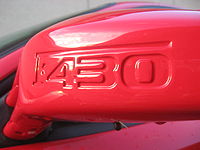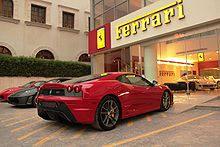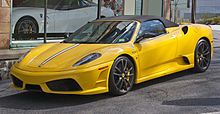Ferrari F430
| Ferrari F430 | |
|---|---|
 | |
| Overview | |
| Manufacturer | Ferrari |
| Also called | 430 |
| Production | 2004–2009 |
| Assembly | Maranello, Italy |
| Designer | Frank Stephenson at Pininfarina[1] |
| Body and chassis | |
| Class | Grand tourer |
| Body style | 2-seat Berlinetta 2-seat Spider |
| Layout | Rear mid-engine, rear-wheel drive |
| Powertrain | |
| Engine | 4.3 L Ferrari F136 E V8 |
| Transmission | 6-speed manual 6-speed 'F1' electrohydraulic manual |
| Dimensions | |
| Wheelbase | 102.4 in (2,601 mm) |
| Length | 177.6 in (4,511 mm) |
| Width | 75.7 in (1,923 mm) |
| Height | Coupe: 47.8 in (1,214 mm) Spider: 48.6 in (1,234 mm) |
| Curb weight | 1,450 kg (3,197 lb) |
| Chronology | |
| Predecessor | Ferrari 360 |
| Successor | Ferrari 458 |
The Ferrari F430 is a sports car that was produced by the Italian car manufacturer Ferrari from 2004 to 2009. A successor to the Ferrari 360, it debuted at the 2004 Paris Motor Show.[2] Its successor, the Ferrari 458, was unveiled on 28 July 2009.[3]
Overview
The MSRP for a Ferrari F430 was $186,925 to $217,318 in the United States,[4] £119,500 in the United Kingdom,[5]approximately €175,000 in the European Union, and $379,000 for the base model to $450,000 for the Spider F1 in Australia and New Zealand.
Design
Designed by Pininfarina, under the guidance of Frank Stephenson, the body styling of the F430 was revised from its predecessor, the Ferrari 360, to improve its aerodynamic efficiency. Although the drag coefficient remained the same, downforce was greatly enhanced. Despite sharing the same basic Alcoa Aluminium chassis, roof line, doors and glass, the car looked significantly different from the 360. A great deal of Ferrari heritage was included in the exterior design. At the rear, the Enzo's tail lights and interior vents were added. The car's name was etched into the Testarossa-styled driver's side mirror. The large oval openings in the front bumper are reminiscent of Ferrari racing models from the 60s, specifically the 156 "sharknose" Formula One car and 250 TR61 Le Mans cars of Phil Hill. Designed with soft-top-convertible.
Engine
The F430 features a 4.3L V8 petrol engine of the "Ferrari-Maserati" F136 family. This new power plant was a significant departure for Ferrari, as all previous Ferrari V8's were descendants of the Dino racing program of the 1950s. This fifty-year development cycle came to an end with the entirely new 4.3L, the architecture of which is expected to replace the Dino-derivedV12 in most other Ferrari cars. The engine's output specifications are: 490 PS (360 kW; 483 hp) at 8500 rpm and 465 N·m (343 lb·ft) of torque at 5250 rpm, 80% of which is available below 3500rpm. Despite a 20% increase in displacement, engine weight grew by only 4 kg and engine dimensions were decreased, for easier packaging. The connecting rods, pistons and crankshaft were all entirely new, while the four-valve cylinder head, valves and intake trumpets were copied directly from Formula 1 engines, for ideal volumetric efficiency. The F430 has a top speed in excess of 196 mph (315 km/h)[6] and can accelerate from 0 to 62 mph (100 km/h) in 3.7 seconds, 0.7 seconds quicker than the old model, while Scuderia version of the F430 is faster, at only 3.5 seconds.[7]
Brakes
The brakes on the F430 were designed in close cooperation with Brembo (who did the calipers and discs) and Bosch (who did the electronics package),[8] resulting in a new cast-iron alloy for the discs. The new alloy includes molybdenum which has better heat dissipation performance. The F430 was also available with the optionalCarbon fibre-reinforced Silicon Carbide (C/SiC) ceramic composite brake package. Ferrari claims the carbon ceramic brakes will not fade even after 300-360 laps at their test track.
Features
The F430 featured the E-Diff, a computer-controlled limited slip active differential which can vary the distribution of torque based on inputs such as steering angle and lateral acceleration.[2][9]
Other notable features include the first application of Ferrari's manettino steering wheel-mounted control knob.[2] Drivers can select from five different settings which modify the vehicle's ESC system, "Skyhook" electronic suspension, transmission behavior, throttle response, and E-Diff. The feature is similar to Land Rover's "Terrain Response" system.
The Ferrari F430 was also released with exclusive Goodyear Eagle F1 GSD3 EMT tires, which have a V-shaped tread design, run-flat capability, and OneTRED technology.[10]
In the US, the company requested an exemption from the airbag design requirements, which was eventually granted, allowing the car to continue to be sold in the US.[11]
Variants
F430 Spider
The F430 Spider is the convertible version based on the coupé. The F430 Spider is Ferrari's 21st road going convertible. The Ferrari F430 Spider made its world premiere at the Geneva motor show. The car was designed by Pininfarina with aerodynamic simulation programs also used for Formula 1 cars.[12] The roof panel automatically folds away inside a space above the engine bay. The conversion from a closed top to an open-air convertible is a two-stage folding-action. The interior of the Spider is identical to that of the coupé.
F430 Challenge
The F430 Challenge is the track version of the F430, designed for the Ferrari Challenge. The engine remained untouched but the vehicle's weight was reduced, resulting in a top speed of 202 mph (325 km/h). The production model was unveiled at the Los Angeles Auto Show in January, 2005.
430 Scuderia
Serving as the successor to the Challenge Stradale, the 430 Scuderia (scuderia meaning "stable of horses", but also used in the context of motor racing teams, including Ferrari's own) was unveiled by Michael Schumacher at the 2007 Frankfurt Auto Show. Aimed to compete with cars like the Porsche RS-models and the Lamborghini Gallardo Superleggera (superleggerameaning super light weight), it is lighter (by 100 kg/220 lb) and more powerful (510 PS (375 kW; 503 hp) at 8500 rpm) than the standard F430. Increased power comes from a revised intake, exhaust, and an ion-sensing knock-detection system that allows for a higher compression ratio.[13] Thus the weight-to-power ratio is reduced from 2.96 kg/hp to 2.5 kg/hp. In addition to the weight saving measures, the Scuderia semi-automatic transmission gained improved "Superfast", known as "Superfast2", software for faster 60 millisecond shift-times. A new traction control system combined the F1-Trac traction and stability control with the E-Diff electronic differential. The Ferrari 430 Scuderia accelerates from 0-100 kilometres per hour (62 mph) in 3.6 seconds,[14] with a top speed of 202 miles per hour (325 km/h).[15] Ferrari claims that around their test track, Fiorano Circuit, it matches the Ferrari Enzo, and the Ferrari F430's successor, the Ferrari 458.
Scuderia Spider 16M
To commemorate Ferrari's 16th victory in the Formula 1 Constructor's World Championship in 2008, Ferrari unveiled the Scuderia Spider 16M at World Finals in Mugello. It is a convertible version of the 430 Scuderia.
The engine produces 510 PS (375 kW; 503 hp) at 8500 rpm and 470 N·m (350 lb·ft) torque at 5250 rpm. The car has a dry weight of 1,340 kg (2,954 lb) (80 kg lighter than the F430 Spider) and a curb weight of 1,440 kg (3,175 lb). The chassis was stiffened to cope with the extra performance available and the car featured many carbon fibre parts as standard. Specially lightened front and rear bumpers (compared to the 430 Scuderia) were a further sign of the efforts Ferrari was putting into this convertible track car for the road. Unique 5-spoke forged wheels were produced for the 16M's launch and helped to considerably reduce unsprung weight with larger front brakes and callipers added for extra stopping power (also featured on 430 Scuderia). It accelerates from 0-100 km/h (62 mph) in 3.7 seconds, with a top speed of 315 km/h (196 mph).[16]
499 vehicles were released beginning early 2009 and all were pre-sold to select clients.[17]
F430 Spider Bio Fuel
A version of the F430 Spider that runs on ethanol, called the F430 Spider Bio Fuel, was on display at the 2008 Detroit Auto Show.[18] It contained the same 4.3 litre V8 engine, producing 500 hp (373 kW), with a 4% increase in torque, with 5% less carbon dioxide emissions than the standard F430 Spider.[18]
SP1
The F430-based Ferrari SP1 (Special Project Number 1), was the first one-off special produced by the Ferrari Portfolio Program. The body was designed by former Pininfarina designer Leonardo Fioravanti, at the behest of Junichiro Hiramatsu, a Japanese businessman who was the former president of the Ferrari Club of Japan and an avid collector; he had admired Fioravanti's 1998 F100 prototype.[19]
Racing
F430 GTC
Built since 2006 by Ferrari Corse Clienti department in collaboration with Michelotto Automobili, the F430 GTC is a racing car designed to compete in international GT2 class competition, such as in the American Le Mans Series, Le Mans Series, and FIA GT Championship. F430 GTCs also compete at the 24 Hours of Le Mans. The GTC was the fastest and most developed racing version of the F430.
In FIA GT2 championship, in order to render the car performances more uniform, the cars are forced to run with a specific minimum weight and with an engine restrictor that depends on the engine displacement.[20] Hence the 4.3 L V8 engine in GT2 races is destroked to 4.0 L in order to compete in the 3.8–4.0 L class, which is allowed to race with a minimum weight of 1,100 kg (2,425 lb).[20] Using the 4.0 L engine, the minimum weight of the F430 would increase by 50 kg (110 lb).[20] In this race configuration, the engine produces somewhat less power, but this is compensated by the lower car weight, which yields a better Power-to-weight ratio.
The F430 GTCs won their class championships in the ALMS and FIA GT, as well as scoring class wins at the 2007,[21] 2009 and 2010 12 Hours of Sebring, at the2008 and 2009 24 Hours of Le Mans and at the 2008 and 2009 Petit Le Mans.
Specifications
- Category: American Le Mans GT2
- Machine manufacturer: Ferrari
- Machine designation: F430 GT2
- Chassis construction and materials: Aluminum composite monocoque, steel safety cage (per IMSA/ACO/FIA rules), engine and gearbox stiffly fitted to the chassis. Windshield, side and rear windows made by polycarbonate glass composite
- Bodywork: Carbon fibre, kevlar, nomex and aluminium
- Engine manufacturer: Custom-built Scuderia Ferrari
- Engine designation: F136
- Engine configuration: V8 engine
- Engine V-angle: 90° cylinder angle
- Engine type: Atmospheric water-cooled engine
- Engine displacement: 4.0 L (4,000 cc; 244 cu in)
- Engine position: Mid-engined, longitudinally-mounted
- Aspiration: Normally-aspirated
- Cylinder block: Aluminium alloy
- Cylinder head: Aluminium alloy
- Valvetrain: DOHC, 32-valve, four valves per cylinder
- Intake air restrictors: 2 x 28.6 mm according to IMSA/ACO/FIA regulations
- Bore: 92 mm (3.62 in)
- Stroke: 75.2 mm (2.96 in)
- Cylinder bore spacing: 4.1 in (104 mm)
- RPM rev limit: 9000 rpm
- Power output: 450 hp (336 kW; 456 PS) @ 7000 rpm
- Torque: 360 ft·lbf (490 N·m) @ 5500 rpm
- Pistons: Mahle aluminium alloy
- Engine management: Magneti Marelli
- Fuel: Ethanol E10 (10% Ethanol, 90% gasoline)
- Fuel delivery: Magneti Marelli MRV8 electronic fuel injection
- Gearbox: Hewland manual sequential 6 speed + reverse sequential gearbox control gear change time 500 milliseconds operated via gear shift lever
- Clutch: Brembo 139.7 mm (6 in) synthesized 3-discs carbon composite dry clutch operated via foot-pedal clutch
- Differential: Self-locking, adjustable by blades
- Drivetrain: Rear-wheel drive
- Drive shafts: Constant-velocity tripod slip-joint shafts
- Exhaust systems: Tubi 4-way inconel fabricated exhaust manifold headers. Rearside exit
- Filter: FIAMM/Dow Automotive
- Spark plugs: Magneti Marelli
- Ignition: Magneti Marelli CDI
- Car wiring harness: Magneti Marelli
- Data logging systems: Magneti Marelli
- Battery: Magneti Marelli 12 Volts
- Lubrication: Quaker State dry sump
- Radiator fluid: Quaker State Antifreeze
- Brake fluid: Brembo HTC64T (DOT 4)
- Length: 4,512 mm (178 in)
- Width: 2,000 mm (79 in) excluding side rear view mirrors, 2,220 mm (87 in) including side rear view mirrors
- Height: 1,175 mm (46 in) minimum, 1,199 mm (47 in) maximum depending on the use of ride height
- Wheelbase: Between 2600-2608 mm (102.4-102.7 in)
- Front axle track width: 1,696 mm (67 in)
- Rear axle track width: 1,640 mm (65 in)
- Minimum weight: 1,100 kg (2,425 lb) excluding driver and fuel, 1,200 kg (2,646 lb) including driver and fuel. All the liquids standard level
- Fuel tank capacity: 19 imperial gallons (86 litres; 23 US gallons)
- Steering: Rack and pinion system, power steering
- Bearings: SKF
- Aerodynamics: Front fenders, rear apron, hood, roof, trunk lid, rear wing, and rear wheel arches in carbon-fibre. Adjustable single-element rear wing, carbon floor with rear diffuser
- Brakes: Brembo ventilated carbon-fibre reinforced silicon carbide ceramic steel composite discs, 6 pistons (front) and 4 pistons (rear) calipers, adjustable brake balance. AP Racing/Brembo callipers, Brembo pads
- Front brake size: 380 × 32 mm
- Rear brake size: 332 × 32 mm
- Dampers: Öhlins
- Springs: Eibach Springs
- Shock absorber kits: Öhlins
- Suspensions (front and rear): Öhlins independent wheels, overlapped aluminium triangular wishbones, adjustable shock absorbers, adjustable anti-roll bar
- Wheel rims: BBS forged aluminium wheels
- Front wheel size: 10 x 18 in
- Rear wheel size: 11 x 18 in
- Tyres: Michelin Pilot, Hankook Ventus radial slick dry and treaded rain tyres
- Front tyre size: 30/65 - R18
- Rear tyre size: 31/71 - R18
- Safety equipment: Sabelt 6-point seat belt, rear view mirror, HANS device, helmet, headsock, race suit, NOMEX firesuit, racing gloves, racing socks, racing boots, headlights, windshield wipers, roll cage, racing seats
- Headlights: Hella 15 volts
- Racing seats: OMP
- Roll cage: Ferrari-built OMP high-strength steel roll cage
- Cockpit features: Hurst short throw shifter, fire suppression activation switch, electrical system cut-off
- Cockpit drinking system: H2O mineral water which connect the pipe from water bag cockpit to the driver's helmet
- Display instrumentation: Magneti Marelli DDU 210 LCD display
- Steering wheel: Scuderia Ferrari OMP/MOMO racing steering wheel
- Traction control: Allowed, adjustable TC level
- Machine assembly plant: Ferrari F430 GT build Ferrari Corse Clienti facility Maranello, Italy
- Teams: Risi Competizione, Petersen Motorsports/White Lightning Racing, Corsa Motorsports, JMB Racing, Tafel Racing (since 2008)









No comments:
Post a Comment